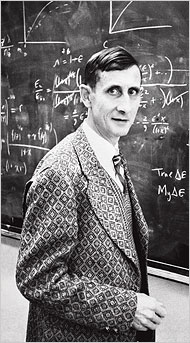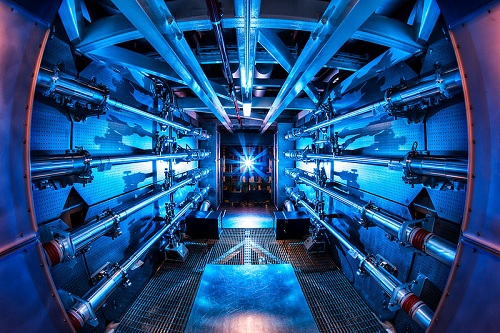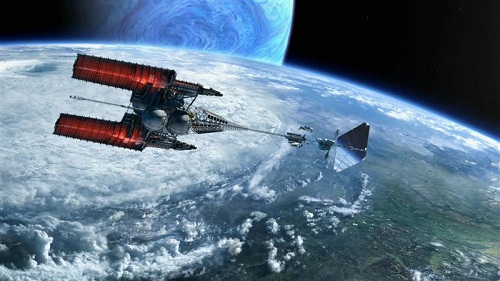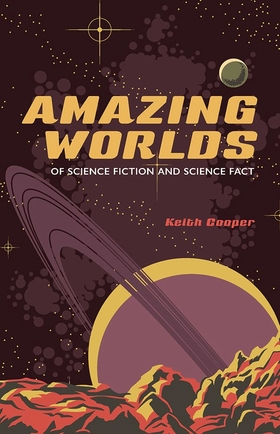Centauri Dreams
Imagining and Planning Interstellar Exploration
More on the Starship ‘Slingshot’ Maneuver
Although we ordinarily think of Stanislaw Ulam in connection with pulse propulsion — and in particular with the Orion concept, in which nuclear devices are exploded behind the spacecraft — the scientist was also investigating other propulsion ideas. It puts yesterday’s discussion of Freeman Dyson’s ‘gravitational machines’ into context to realize that Ulam was writing about obtaining ‘a velocity arbitrarily large — that is, close to the velocity of light…’ using gravitational slingshots around astronomical objects in papers written as early as the late 1950s. There is, as Greg Matloff and Eugene Mallove remind us in The Starflight Handbook fantastic energy available in the orbital motion of celestial bodies. How best to tap it?
Michael Minovitch was already working at UCLA in the early 1960s on how to use a gravity ‘slingshot’ to affect spacecraft trajectories, thus extending the capacity for exploration. Dyson’s futuristic paper, as we saw yesterday, described gravitational machines involving white dwarfs and, quite presciently for the time, neutron stars back in 1963, just a few years after Ulam’s studies had concluded that gravitational maneuvers were possible but impractical for high velocities. One can easily object to Dyson’s thinking by asking how even an advanced civilization could manipulate neutron stars and, for that matter, how it might use such a transportation system. But Dyson’s thinking was aspirational. He wondered what might be possible for extraterrestrial cultures because this was a way of looking into possible human futures.
Matloff and Mallove quote Dyson on the matter: “There is nothing so big nor so crazy that one out of a million technological societies may not feel itself driven to do, provided it is physically possible.” It’s a thought that quickens speculation. And if we put our minds to it and run it through a science-fictional process of extrapolation, maybe a culture that already has interstellar travel would find it useful to have a kind of automated propulsion system that could routinely fling a payload out at almost 30 percent of the speed of light. Exactly how they might manage it and what their intentions would be will remain a mystery to a culture at our technological level.
A gravitational machine using neutron stars would subject the spacecraft using it to stupendous tidal forces, but a culture that can master neutron star engineering would perhaps find a way around these as well. In any case, in a time when we are thinking about ‘interstellar archaeology’ as a new mode for SETI, double star gravitational accelerators make one more possible artifact, or perhaps I should say, one more astronomical object near which we might look for signs of extraterrestrial engineering. A Kardashev Type II civilization might thus reveal its presence not in the form of a beamed radio or optical signal but rather through the works of its engineers.

But let’s get back closer to home. Yesterday I mentioned Krafft Ehricke’s own ideas on gravitational maneuvers in the form of a deep-space probe he thought could be accelerated to speeds that would make a mission to the inner Oort Cloud possible in a 50-year time-frame. In a 1983 paper in JBIS, Matloff and Mallove had initially confirmed Ehricke’s figures, assuming a close solar approach (to within 0.01 AU of the Sun’s center, or two solar radii) and factoring in no powered perihelion maneuver. But in a subsequent paper, Matloff went on to revise the numbers, finding what he calls a ‘subtle error’ in the original calculations.
Image: Interstellar theorist Gregory Matloff. Credit: CUNY.
Working with Kelly Parks, Matloff computed the velocities obtainable by a worldship falling toward the Sun and grazing the solar photosphere at 0.005 AU from the Sun’s center, with a 10 km/sec propulsive maneuver applied at perihelion. The result: “The hellish penetration of the solar atmosphere at 600 km/sec would occur in a relatively short but sizzling half-hour period. With the 10 km/sec maneuver, the starship would exit the Solar System with a hyperbolic excess velocity of 110 km/sec…” Doubling the perihelion maneuver to 20 km/sec gets you up to 156 km/sec as you exit. This is the sound of anti-climax, a nice bump up over Voyager-style speeds, but one that still leaves you with an Alpha Centauri crossing that takes close to 8000 years.
We can do better than this with a ‘Sun-diver’ maneuver involving solar sails, but that is a topic for another day. The paper is Matloff and Parks, “Interstellar Gravity Assist Propulsion,” JBIS 41 (November, 1988), pp. 519-526.

The Interstellar Gravitational Assist
While Rod Hyde, Lowell Wood and John Nuckolls were working on laser-induced fusion to drive a starship back in 1972, the range of options for advanced propulsion continued to grow. One we haven’t talked about much in these pages is the use of gravitational slingshots in exotic settings. We’re used to the concept within the Solar System because spacecraft like Voyager and Galileo have used a ‘slingshot’ around a planet to alter course and accelerate. But interstellar visionaries like Freeman Dyson have looked further out to imagine other uses for such techniques.

In a 1963 paper, Dyson speculated on how an advanced civilization might use a binary star system made up of two white dwarfs. Send a spacecraft into the system for a close pass around one of the stars and, depending on the mass and orbital velocity of the stars, it is thrown out of the binary system at velocities as high as 3000 kilometers per second. But Dyson took the idea even further. His paper, which appeared as a chapter in a book called Interstellar Communication (New York: Benjamin Press, 1963), described not just white dwarfs but the creation of a binary neutron star system as an engineered launch platform.
I can’t, in a quick search of the office this morning, find my copy of this book, but David Darling has the numbers in his Encyclopedia of Science. Two neutron stars, each with a diameter of 20 kilometers and a mass of one solar mass — and a combined orbital period of 0.005 seconds — would provide a departure velocity of 0.27 c, which works out to 81,000 kilometers per second. The concept has worked its way into the literature as the ‘Dyson slingshot,’ an artifact produced by an advanced civilization for flinging things from star to star. See Gregory Benford’s The Stars in Shroud (1978) for possible uses of such a system.
Image: Freeman Dyson pushed gravitational maneuvers to an extreme. Will future civilizations be able to manipulate neutron stars? Credit: New York Times
All this was in the air at a time when the very existence of neutron stars was in doubt (it would not be until five years later that Jocelyn Bell and Antony Hewish discovered the first radio pulsars, for which Hewish shared the Nobel Prize). Why get into all this in a book titled Interstellar Communication? Because Dyson also noted that a close binary system of neutron stars would decay in short order until the two components plunged into each other, creating a burst of gravitational waves that could be detected over millions of parsecs. Dyson thought it worth looking for events like this using some form of gravitational wave detection instrument.
But back to gravitational maneuvers to speed up spacecraft. Writing in the Journal of the British Interplanetary Society in 1972, German propulsion engineer Krafft Ehricke proposed using a gravitational slingshot to push a spacecraft out a tenth of a light year from the Sun. These days the plan would sound more familiar than it did when Ehricke wrote it: The probe would be sent first to Saturn for a propulsive maneuver as it moved behind the planet that would send it into a retrograde orbit, taking it near Jupiter for another slingshot toward the Sun.
Ehricke’s vehicle would close to within 1.6 million kilometers of the Sun, being flung around it and accelerated to 600 kilometers per second, which would take it to 6320 AU in 50 years. The engineer thought a mission like this could be useful as we learn about the interstellar medium and the outer system, but he believed 600 kilometers per second was about as much as he could wring out of the method. Actual interstellar missions would need breakthroughs of the kind Hyde, Wood and Nuckolls were examining at Lawrence Livermore, or perhaps antimatter.
I’m not clear on whether Ehricke was aware of the 1960s work of Robert Forward, George Marx (Roland Eötvös University, Hungary) and J.L. Redding (Bishop’s University, Quebec) on laser beaming to large space-based sails, but I haven’t yet found any reference to it in his work. He did, however, develop expansive ideas about our species’ role in the cosmos that I’ll be looking at shortly.
The Dyson paper is “Gravitational Machines,” in A.G.W. Cameron, ed., Interstellar Communication, New York: Benjamin Press, 1963, Chapter 12. Krafft Ehricke’s paper on gravitational assist is “Saturn-Jupiter Rebound: A Method of High-Speed Ejection from the Solar System,” JBIS 25:10 (October, 1972), p. 561.

Conceiving the Laser-Fusion Starship
When young Rod Hyde, fresh out of MIT, started working on starship design in mid-1972, there were not many fusion-based precedents for what he was up to. He had taken a summer job that would turn into a career at Lawrence Livermore National Laboratory, but right off the bat he was involved with Lowell Wood and John Nuckolls in a concept that would use a battery of lasers to create fusion reactions whose energy would be channeled out the back of the ship by magnetic nozzles. Wood and Nuckolls had been developing their ideas for years, after Nuckolls first began to ponder how to use laser fusion micro-explosions to drive a spacecraft.
Now the duo had a kid who had spent his previous summers working in a beet cannery, a recruit for Livermore who had run up high grades at MIT and had shown he could work like a demon once he put his mind to it. This would be his first technical job. Hyde went into full gear on containing the plasma from the fusion explosions with a magnetic field. If they could ignite fusion, the three researchers were looking at specific impulses of 300,000 seconds and maybe as high as a million.
The figure was staggering. The amount of time it takes one pound of fuel to produce one continual pound of thrust gives you the specific impulse figure. It’s one way to measure rocket performance. Putting the work of Hyde, Wood and Nuckolls in context, consider that the main engines of the Space Shuttle can turn out a specific impulse of about 455 seconds. Hyde couldn’t talk about the specifics of the fusion pellets and laser ignition in this engine when he presented it in late 1972 at a conference of the American Institute of Aeronautics and Astronautics in New Orleans, but even the declassified version made quite a splash.

Image: We’re still trying to turn fusion into a reliable power source here on Earth. Pictured are the pre-amplifiers of the National Ignition Facility at LNLL. Will we ever find a way to use inertial confinement fusion powered by lasers on a spacecraft? Credit: Damien Jemison/LLNL.
A Memorable Conference
Remember, this was shortly before Daedalus, the British Interplanetary Society’s starship design project that began in 1973. Daedalus would go on to develop a concept around inertial confinement fusion ideas produced by Friedwardt Winterberg, a theoretical physicist at the University of Nevada in Reno. In later years, Hyde would question some of the Daedalus work, about which more in a moment. For now, let me quote Thomas Heppenheimer, who wrote about the New Orleans conference and the starship design in his book The Man-Made Sun (Little Brown, 1984). Heppenheimer says the paper took the conference by storm:
Hyde stood up there at the podium and laid it all out: the physics, the design concepts, the calculations, the performance equations. Almost nobody in the audience had the background to follow him. Still, the paper was a blockbuster, for it had about it the aura of classified technology. People didn’t know much in those days about laser fusion, though it was considered quite a hot topic, but nobody could say why. Also, the word got around that Wood had had a hard time getting the paper cleared through classification so that it could be released. The government had just barely, and reluctantly, let it out. Then the requests for copies of the paper started pouring in.
And pour in they did. Wood had ordered two hundred reprints and surely thought he had grossly overestimated the demand, but the papers were gone in two months and the starship designers were sending out copies from the lab’s copy machines. The 19-year old Hyde found his paper being sought out by the White House and the National Security Council. Hyde would go on to develop a much longer report based on the paper, spending the ensuing years developing how the laser would work and covering details from radiation shielding to power equipment.
Radiators and Starship Design
Yesterday I ran an image from the film Avatar to accompany the first of these articles on Hyde, Wood and Nuckolls’ ideas. The choice was deliberate because the ISV Venture Star has what many cinematic starships lack: A set of radiators. Think about the fact that while a rocket of any kind will produce heat, a vehicle like the Space Shuttle is also cooled by the flow of hydrogen fuel (over 440 pounds of hydrogen per second). Fusion engines can’t shed their heat as readily. They demand radiators that will glow red-hot as they carry the heat away. Hyde saw this early in the game and spent a lot of time working on the radiators and their supporting equipment.
The engine design that Hyde took to New Orleans was based on inertial confinement fusion as conceived by Wood and Nuckolls, a concept intended to move far beyond Orion, with its nuclear devices exploded behind the spacecraft to drive it forward. The new design would use frozen pellets of deuterium/tritium, each weighing 0.015 grams, 500 of which would be exploded by lasers every second. The result would be a tiny fireball whose charged particles would be turned into the exhaust beam by magnetic coils. The fireball would in turn press the magnetic field to induce current in a pickup coil, flowing into a capacitor whose discharge would fire the lasers.
When Hyde later looked at the Daedalus papers, developed not long after his initial work with Wood and Nuckolls, he balked over the issue of the fuel pellets, thinking that the design was unworkable. The Daedalus designers had based their pellet design on unclassified literature, but Hyde knew there was a great deal more about pellet design than could be reported in the press. When he ran the BIS’ pellets through the LASNEX computer code then in use at Livermore, he found they produced little thrust, and if re-engineered to create thrust, would melt the engine.
With breakeven fusion proving a tougher nut to crack than appeared likely in the 1970s, it’s almost wistful to look back at some of the excitement these methods produced in that era. Thomas Heppenheimer talked of using the Hyde/Wood/Nuckolls design to boost a spacecraft to ten percent of the speed of light for a flyby mission to a nearby star, diverting to another after the first encounter. A probe to Barnard’s Star, for example, would reach its target in 64 years, after which it would be re-deployed toward 70 Ophiuchi, which it would reach some 92 years later.
Today we’re re-examining the whole concept of inertial confinement fusion, with ongoing work at the National Ignition Facility located at Livermore. In starship terms, the Icarus project is massaging the Daedalus report to bring it up to speed with current thinking and technology, even as the question of flyby probes is giving way to a realization that without a means of decelerating, we’ve spent vast amounts of money on mere hours of close-in data. Whether the intense work that resulted in Hyde’s final designs will ever pay off in terms of an actual mission to a star remains to be seen, but the ideas he worked with at Livermore continue to be a vital part of interstellar studies, energizing continued work on the conundrum of fusion propulsion.
For more on all this, the original conference paper is Hyde, Wood and Nuckolls, “Prospects for Rocket Propulsion with Laser Initiated Fusion Microexplosions.” AIAA Paper 72-1063, American Institute of Aeronautics and Astronautics, November 1972.

Starship Design: Rod Hyde, Reykjavik and Chess
Growing up in Corvallis, Oregon, math prodigy and future weapons designer Rod Hyde seemed to have two things on his mind: chess and science fiction. Gordon Dickson, Keith Laumer and Robert Heinlein had fed his adolescence with images of man’s future in space, and by the time he was interviewed by the New York Times‘ William Broad for a book called Star Warriors (1985), he was talking about getting humans off the planet as a means of species survival. Rod was at Lawrence Livermore National Laboratory then, deep in the world of nuclear weapons design and the ideas that would emerge as ‘Star Wars.’
Not the movie, of course, but the Reagan-era defensive shield that would, it was hoped, bring down incoming missiles and forever alter the balance of power. As anti-Soviet as they come, Hyde always took the long-range view when the conversation moved to the future. He tells Broad:
“What I want more than anything is essentially to get the human race into space. It’s the future. If you stay down here some disaster is going to strike and you’re going to be wiped. If you get into space and spread out there’s just no chance of the human race disappearing.”

I was thinking about all this today because last night I gave a talk on interstellar mission concepts and discussed species survival as a driver for building up the space-based infrastructure that might eventually make them possible. But I also thought about the young Rod Hyde because I was once, totally without my knowing it, in the same venue with him in Reykjavik, Iceland. Back in 1972, Bobby Fischer went to Reykjavik to take on Russia’s Boris Spassky in a world championship chess match. I was in Reykjavik because I was studying Old Norse, the language of the Vikings, and the direct ancestor of modern Icelandic. Hyde was there for the chess.
Image: Bobby Fischer (right) shoots Boris Spassky a glance as the latter mulls his position in 1972’s world chess championship. Credit: Morgunblaðið.
Now Reykjavik is a small place, back then about 80,000, and when I wasn’t in the museums or the incredibly numerous bookstores, I went to as many of the chess matches as I could, where Fischer put on his usual antics, like showing up after the clock had already started and swooping in with affected nonchalance to make his opening move. A chess championship at that level is a bit surreal. No one dared to make a sound, and if even a rustle of whispering broke out in the audience, the Icelandic word þögn! (silence) would instantly appear on the screen above the players. Because long thought went into each move, watching the match mostly involved being perfectly still and waiting for something to happen.
The crowd loved it. Icelanders love chess anyway, doubtless the result of long indoor hours during the dark winter, which also explains the ubiquitous bookshops. They would sit in silence for long minutes until one of the players made a move. Then nods would break out, or perhaps a sigh. Sometimes the move was dramatic, and then a collective gasp would go up as Spassky or Fischer seemed to get the edge. I would see people glancing at each other in puzzlement or approval and resolved to learn how to play chess better, a promise I never really kept.
I bet Hyde had the time of his life. The Reykjavik championship had come just at the time when his designs for a starship had reached completion. Back in 1972, Rod had finished up at MIT and, when not playing in chess tournaments of his own, had begun to look for graduate fellowships. The search led to an offer of a summer job working on laser fusion rockets with Livermore’s Lowell Wood. The 19-year old thus went to work at the weapons lab and, working with the ideas of Wood and John Nuckolls, developed a design for a starship engine that would put out power like no engine ever had. He had fusion in mind, and his thoughts had been influenced by laser developments.

Image: The ISV Venture Star, from James Cameron’s film Avatar. Note the radiators, about which more tomorrow. Credit: Lightstorm Entertainment/20th Century Fox.
Broad tells the story: Rod was transfixed by the starship idea but, as a huge fan of Fischer’s, determined to be in Reykjavik for the chess championship. He began working long days and into the night pounding on the design, at one point locking himself in his office for four straight days to produce a final paper that would later be presented at a conference in New Orleans. Broad says that Lowell Wood led the sleep-deprived Hyde out to his car to take him to the airport for the Iceland flight, and we can only hope that he somehow got a bit of sleep on the plane. I doubt it, though, because in those days going to Iceland involved an aged DC-8 with cramped seats, a noisy cabin, and usually a full passenger manifest. I lost a lot of sleep on those crossings.
But Hyde was a genuine workaholic. I’ve already mentioned his youth when he received his undergraduate degree, and once he began at Livermore, he split time between the lab and MIT as he went on to receive an M.S. in 1973 and, now working full-time at Livermore, a doctorate in 1976. He was contemptuous of Soviet rocket design and deeply distrustful of Soviet intentions, but underlying all the personal geopolitics was the idea of space as a solution to human problems. Broad quotes him in the course of a long interview on the political situation of the time:
“I want the future to be up in space because there is just so much more out there… Here you can’t play games with new political systems because every piece of land is already owned by someone. It’s a zero-sum game. Out there, it’s absolutely limitless. There’re no more frontiers here. Space is one big frontier.”
Thus Rod’s membership in the Citizens Advisory Council on National Space Policy, which science fiction writer Jerry Pournelle had founded, and which was sponsored by both the American Astronautical Society and the L-5 Society. And thus his obsession with going to the stars, which obviously grew out of a childhood steeped in science fiction coupled with a mathematical and engineering bent that led him to seek new solutions. Tomorrow I want to talk a bit more about Hyde and the starship ideas that would emerge from this restless polymath.

A New Free-Floating Planet Candidate
Planets without stars may exist throughout the galaxy, and some studies suggest that there may be more so-called ‘rogue planets’ than main sequence stars. Now we get word of an object called CFBDSIR2149, associated with the stream of young stars called the AB Doradus Moving Group, a group of about 30 stars of the same age and metallicity associated with the star AB Doradus. The object turned up at infrared wavelengths in the Canada-France Brown Dwarfs Survey (CFBDS), which is looking for cool brown dwarf stars. If the object is indeed part of the AB Doradus group, then we can deduce that it is young (50-120 million years) and, according to this ESO news release, a number of its other properties can be inferred.
Image (click to enlarge): This image captured by the SOFI instrument on ESO’s New Technology Telescope at the La Silla Observatory shows the free-floating planet CFBDSIR J214947.2-040308.9 in infrared light. This object, which appears as a faint blue dot at the centre of the picture and is marked with a cross, is the closest such object to the Solar System. It does not orbit a star and hence does not shine by reflected light; the faint glow it emits can only be detected in infrared light. The object appears blueish in this near-infrared view because much of the light at longer infrared wavelengths is absorbed by methane and other molecules in the planet’s atmosphere. In visible light the object is so cool that it would only shine dimly with a deep red colour when seen close-up. Credit: ESO/P. Delorme
If the association with the AB Doradus group is assumed, then the possible planet is thought to be 4-7 times the mass of Jupiter, with an effective temperature of 430 degrees Celsius. This is the first time an isolated planet has been identified as part of a moving group, but the possibility remains that the association with the group is purely a matter of chance, in which case we could be looking at a small brown dwarf. However, if it really is a rogue planet, CFBDSIR2149 would be a useful find, according to Philippe Delorme (CNRS/Université Joseph Fourier, France):
“These objects are important, as they can either help us understand more about how planets may be ejected from planetary systems, or how very light objects can arise from the star formation process. If this little object is a planet that has been ejected from its native system, it conjures up the striking image of orphaned worlds, drifting in the emptiness of space.”
Bear in mind that we have had previous candidates for this kind of planet, including ‘free floating’ planets in the Orion Nebula (Philip Lucas and Patrick Roche, 2009), planetary mass objects near the star ? Orionis (Maria Rosa Zapatero Osorio, et al., 2000) and a population of ‘unbound or distant Jupiter-mass objects’ discovered through gravitational microlensing (MOA/OGLE, 2011). At about 100 light years from Earth, this new object would be the closest yet to our Solar System, an intriguing candidate for future study and the first to which we could assign an age.
The new work, led by Delorme, interestingly speculates that a small number of low-gravity late T-dwarfs may turn out to be free-floating planets.’ From the paper:
The conclusions for stellar and planetary formation models would also be far reaching. Either the planetary mass-?eld brown dwarfs are mostly the result of a stellar formation process, which would con?rm the fragmentation of a molecular cloud can routinely form objects as light as a few Jupiter masses, [or] these objects are mostly ejected planets. In this case, given that massive planets are less easily ejected from their original stellar system than lower mass ones, and that lighter planets are much more common than heavier ones (see Bon?ls et al. 2011, for instance), this would mean free-?oating, frozen-down versions of Jupiters, Neptunes and perhaps Earths are common throughout the Milky Way interstellar ranges.
See Island Hopping to the Stars for more on this as seen through the work of Louis Strigari (Stanford University), who speculates that there may be up to 105 compact objects per main sequence star in the galaxy that are greater than the mass of Pluto.
The paper is Delorme et al., “CFBDSIR2149-0403: a 4-7 Jupiter-mass free-floating planet in the young moving group AB Doradus?” Astronomy & Astrophysics 14 November 2012 (preprint).

On Super-Earths and Alpha Centauri
The discovery of Centauri B b, a small planet with a mass similar to Earth, continues to percolate in the news even if the initial buzz of discovery has worn off. Science News gives the new world a look in a recent article, noting the fact that with an orbital period of 3.236 days, this is not a place even remotely likely for life. Surface temperatures in the range of 1200 degrees Celsius are formidable obstacles, but of course the good news is the potential for other planets around Centauri B and, indeed, around its larger companion.
Centauri A may well host interesting worlds, but it’s a tough study because it’s given to the kind of stellar activity that can more readily mask a planetary signature than the quieter Centauri B. Even so, we can imagine the possibility of two planetary systems in close proximity, a scenario that would surely propel any technological civilization around one to investigate the other. We don’t have the driver for spaceflight in our system that an Earth-like world around Centauri B might have, a second habitable planet breathtakingly close around another star.
If we’ve ruled out planets larger than Neptune around any of the three Alpha Centauri stars, that leaves the door open for the small worlds that could be the most interesting if one or more turned up in the habitable zone, and it’s worth noting that on this score, Proxima Centauri is still in the game. But right now the incredibly tricky detection of Centauri B b needs confirmation, which could be delivered by Debra Fischer (Yale University). You’ll recall that Fischer has been working at Cerro Tololo (CTIO) in Chile to develop the high-resolution spectrometer known as CHIRON, commissioned in March of 2011, as part of her team’s search for rocky Alpha Centauri planets.
Leaving Copernicus Behind

Centauri B b might also be confirmed through detection of a transit, the chances being estimated in the region of 10% and perhaps, according to Greg Laughlin (UC-Santa Cruz) as high as 25%. While the necessary work continues, let’s move beyond the Alpha Centauri stars for a moment to talk about Laughlin’s latest work with Eugene Chiang. Exoplanet hunters have learned through experience to question assumptions, the most obvious of which is that our Solar System is in some sense ‘normal.’ Or as Laughlin writes on systemic, “There is an intriguing, seemingly anti-Copernican disconnect between the solar system and the extrasolar planets.”
Image: Exoplanet hunter Greg Laughlin, whose latest work re-examines how super-Earths form close to their stars. Credit: UC-Santa Cruz.
Maybe the reason exoplanets so often surprise us is that we base our thinking on our own Solar System, and the minimum-mass Solar nebula from which it grew, considering this a template. The rest of the galaxy may have other ideas. Consider that close-in super-Earths are common. Planets like these, showing up in abundance in Kepler data and Doppler velocity surveys, are a challenge to explain. Laughlin and Chiang say that more than half, if not nearly all Sun-like stars have planets with radii between 2 and 5 times that of Earth and orbital periods of less than 100 days. The researchers write:
Super-Earths are not anomalous; they are the rule that our Solar System breaks. In a sense, the burden of explaining planetary system architectures rests more heavily on the Solar System than on the rest of the Galaxy’s planet population at large.
The problem, then, is that our Solar System has no planets inside Mercury’s 88-day orbit. Is it possible our Solar System did not undergo the same kind of formation history that may be the dominant mode in the galaxy? To explore this, the researchers look at migration issues, for it is commonly thought that short-period planets formed several AU out from their stars and then migrated to their present location. But disk migration is poorly understood, and while it may be necessary to explain hot Jupiters, Laughlin and Chiang say it may not be the mechanism to explain the majority of planetary systems with super-Earths in inner orbits.
The alternative: Forget orbital migration and consider the possibility that super-Earths form right where they are, in circumstellar disks that extend inward from 0.5 AU. The researchers go to work on constructing a new template, the Minimum Mass Extrasolar Nebula (MMEN), which allows them to explore how such planets could form near their star:
Our order-of-magnitude sketches in this regard are promising. In-situ formation at small stellocentric distances has all the advantages that in-situ formation at large stellocentric distances does not: large surface densities, short dynamical times, and the deep gravity well of a parent star that keeps its planetary progeny in place.
The basic properties of planets forming at their current orbital distance are made clear:
In-situ formation with no large-scale migration generates short-period planets with a lot of rock and metal and very little water. The accretion of nebular gas onto protoplanetary cores of metal produces H/He-rich atmospheres of possibly subsolar metallicity that expand planets to their observed radii. Retainment of primordial gas envelopes against photoevaporation leads to planets that can be similar in bulk density to Uranus and Neptune while being markedly different in composition. Close-in planets are not water worlds.
Laughlin and Chiang believe there should be observational consequences to such predictions, making the theory falsifiable. Hot young stars should lack close-in super-Earths because they would be too hot for planetesimal-building dust to survive. Brown dwarfs and M dwarfs should have close-in super-Earths and Earths orbiting them. Close-in planets grown from close circumstellar disks should also have orbital planes aligned with the equatorial planes of their host stars. I’ll send you to the paper to go through the entire list of predictions, all of which should allow these ideas to be probed, but I do want to mention one last prediction having a bearing on Centauri B b. For if Laughlin and Chiang are right, then binary systems offer a good test.
After all, close binary systems should make planetary migration extremely difficult. The close companion would disrupt planet formation at large distances from the star. Planets orbiting Centauri B inside the 0.5 AU boundary would be incompatible with migration, and of course, we now have such a planet, along with the likelihood of finding more. Here I drop back to the Science News article, which quotes Laughlin on Centauri B: “I think that the odds that there’s an interesting planet, a truly interesting planet in the system, are very high, given that this one is there.” And if he’s right, that interesting, potentially habitable world may serve as further evidence for the theory that such planets formed right where they are found.
The paper is Chiang and Laughlin, “The Minimum-Mass Extrasolar Nebula: In-Situ Formation of Close-In Super-Earths,” submitted to Monthly Notices of the Royal Astronomical Society (preprint).



